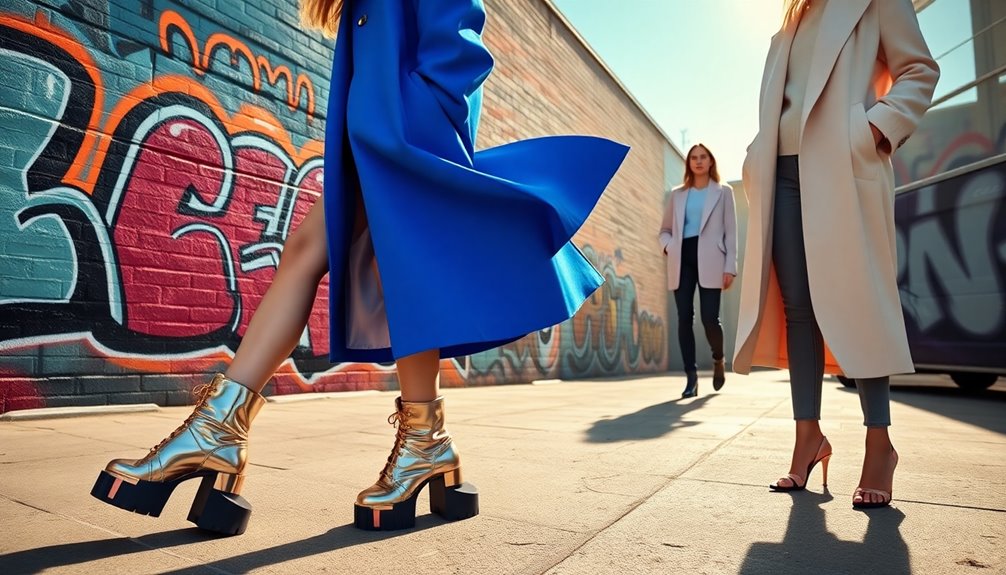The rise of digital fashion houses transforms your experience by offering virtual designs and immersive online showcases that boost creativity, sustainability, and accessibility. They use technology to break down geographical barriers, reduce waste, and enable personalized, interactive encounters with fashion. Virtual runways and digital environments make fashion more innovative and environmentally friendly. As this trend grows, it opens new opportunities for artists, brands, and enthusiasts alike — and there’s more to discover about how this evolution shapes the future.
Key Takeaways
- Digital fashion houses enable virtual design and showrooms, expanding creativity without physical or geographic limitations.
- Virtual runways and environments create immersive experiences, transforming how audiences engage with fashion.
- They promote sustainability by reducing waste, overproduction, and environmental impact associated with physical garments.
- Digital platforms provide new revenue streams, exclusive access, and personalized experiences for consumers.
- Preserving fashion history digitally enhances documentation, cultural preservation, and future innovation in design.

Digital fashion houses are revolutionizing the way we create, showcase, and experience clothing. They’re transforming traditional concepts of fashion by leveraging technology to craft virtual designs and present them in innovative ways. One of the most exciting developments is the virtual runway, where designers can debut their collections in fully digital spaces. Unlike physical runways, virtual runways allow for limitless creativity, removing geographic and logistical barriers. You can attend a show from anywhere, experiencing the designs in immersive, often interactive environments. This shift not only broadens access but also pushes the boundaries of fashion innovation, encouraging designers to experiment with new forms, textures, and concepts that would be challenging or impossible to realize physically.
Digital fashion houses are transforming how we create, showcase, and experience clothing through virtual runways and innovative digital designs.
As you explore digital fashion houses, you’ll notice how they embrace cutting-edge technology to challenge traditional notions of clothing. These houses often operate entirely online, showcasing their collections through 3D renderings, augmented reality, and virtual environments. This approach makes fashion more sustainable, reducing waste and minimizing the environmental footprint associated with producing physical garments. It also enables you to experience fashion in a more personalized, engaging way—imagine trying on digital outfits through your smartphone or virtual reality headset before making a purchase. This integration of technology into fashion design and presentation signifies a major step forward in how clothing is conceptualized, developed, and consumed. Digital fashion platforms are transforming the industry landscape, making it more accessible and innovative. Additionally, advancements in virtual environments are creating more realistic and captivating experiences for users. Moreover, the increasing use of digital fashion history helps preserve and study past designs in new digital formats, enriching the cultural dimension of the industry. This fusion of fashion technology with creative expression is shaping a new era of design possibilities.
The importance of digital fashion houses extends beyond just innovation; they’re reshaping the entire industry landscape. For designers, these platforms offer new opportunities for creative experimentation without the constraints of physical production. For consumers, they provide access to exclusive collections and experiences that wouldn’t be possible otherwise. The virtual runway, in particular, becomes a space where fashion innovation thrives, allowing for storytelling and artistic expression to take center stage. And as the technology continues to evolve, you’ll likely see even more interactive and immersive experiences become commonplace, further blurring the lines between digital and physical fashion. Additionally, the use of high-quality digital visuals enhances the realism and appeal of virtual garments, making digital fashion more enticing and convincing. This ongoing technological evolution ensures that digital fashion remains a dynamic and forward-thinking sector.
Frequently Asked Questions
How Do Digital Fashion Houses Generate Revenue?
You generate revenue from digital fashion houses through virtual showrooms where clients buy or lease digital clothing. Licensing models also play a key role, allowing brands to license their designs for virtual use across platforms. By offering exclusive digital collections, hosting virtual events, and partnering with brands, you create multiple income streams. These methods maximize profits in the digital space, making fashion more accessible and engaging for consumers worldwide.
Are Digital Designs More Sustainable Than Physical Garments?
You might think digital designs are more sustainable because they don’t require physical materials, reducing waste. Virtual sustainability and eco-friendly innovation play a big role here, as digital garments cut down on water use, carbon emissions, and energy consumption involved in manufacturing. While digital designs aren’t completely eco-perfect, they offer a greener alternative to physical garments, helping you reduce your environmental impact without sacrificing style.
Can Digital Fashion Be Considered a Form of Art?
You might wonder if digital fashion qualifies as art. Virtual creativity fuels aesthetic innovation, transforming how we perceive design. By pushing boundaries and exploring new mediums, digital fashion embodies artistic expression. It’s not just about clothing; it’s about storytelling and emotion through virtual creations. So, yes, digital fashion can be considered a form of art, blending technology and imagination to redefine what’s possible in the creative world.
How Do Digital Fashion Houses Influence Traditional Fashion Brands?
You see that digital fashion houses influence traditional brands by encouraging virtual collaborations that blend virtual and physical designs, creating innovative collections. They push brands toward diversification by exploring new styles and digital-only offerings, which appeal to tech-savvy consumers. This shift prompts traditional fashion brands to adapt, incorporating digital elements into their strategies, enhancing their reach, and staying relevant in an evolving industry driven by digital innovation.
What Are the Future Trends for Digital Fashion Houses?
You’ll see digital fashion houses embracing future trends like virtual collaborations and NFTs integration. Expect more brands to partner with artists and influencers in virtual spaces, creating unique digital collections. NFTs will become essential for exclusive ownership and authenticity, driving new revenue streams. As these trends grow, digital fashion will become more innovative and immersive, reshaping how you experience and engage with fashion in virtual environments.
Conclusion
As digital fashion houses continue to grow, you’ll find yourself on the cutting edge of style and innovation. Embracing this new era means staying ahead of the curve and seizing exciting opportunities. Remember, in the world of fashion, it pays to be ahead of the game—otherwise, you’ll miss the boat. So, get ready to plunge into this digital revolution; it’s where the future of fashion is heading, and you don’t want to be left behind.









